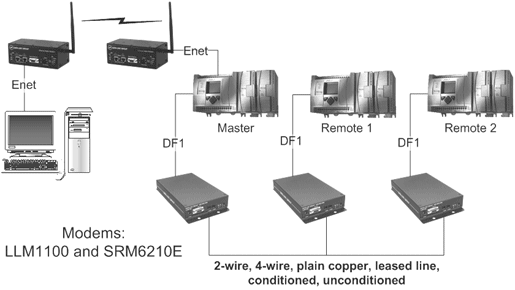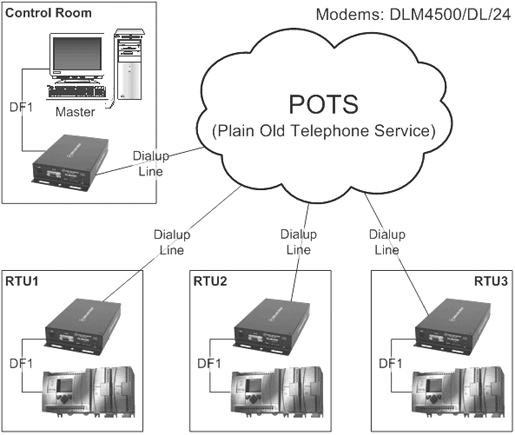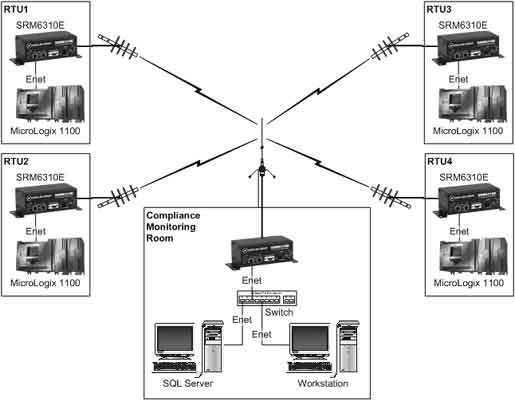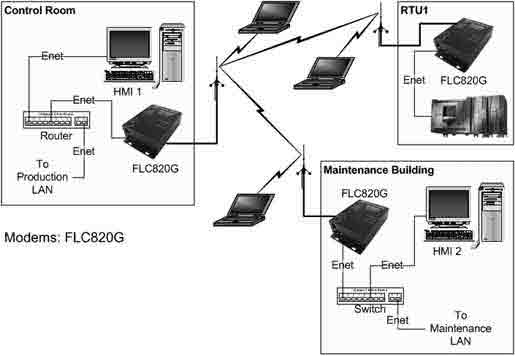|
|
||||
|
||||
|
|
Articles and Technical PapersDesigning the Ultimate RTU – Communication OptionsBy Mike Maes, Larry Terwisscha & Jim Ralston A broad range of communication options are available for SCADA systems to transfer data from Remote Telemetry Units (RTUs) to a central location for system monitoring, process control and data logging. The selection of an appropriate communication method is dependent on many factors including distance between the RTUs and the central location, the existence or absence of wires or fiber optic cable for communication, data speed required, topography and economics. Telephone Line, Dedicated Wire & Fiber Optic MethodsWhen data rate requirements are low (1200 to 19,200 bits per second) and either private or Telco wires are available, several types of wire modems will fit the purpose. With Telco lines (which will have ongoing monthly charges associated them), dial-up modems, which usually involve the lowest monthly cost, can be used if connection time delays of typically 30 to 60 seconds can be tolerated in the application. Otherwise, leased line modems, which are always on line and therefore have lower data delays, are an option. If the Telco leased lines are loaded, communication distance is unlimited as the telephone company will amplify the signal. With private lines (dedicated wires), there is no monthly fee, and private line modems are also always on-line and have relatively short connection delays of 50 ms. Private line modems have typical practical ranges of 4 to 25 miles depending on modulation type and data rate. Direct Ethernet wire connection can be made over modest distances of 300 feet on CAT5 wire Fiber optic modems are available with either serial (RS-232) or Ethernet if cable is in place or can be economically installed. Fiber optic cables provide the highest speeds and offer long distances, but are costly to install and difficult to repair if damaged. One additional option is DSL/Cable where such service is available. This option has high speed, unlimited distance (where service is provided), relatively low initial cost but rather high monthly expense. Since communications is provided by a third party, data communication interruption can occur without notice. Wired & Fiber Communication Comparison
Table 1. The principle characteristics of wired and fiber optic options. |
||
Dial-up Telephone Line Application
Diagram 1. A typical dial-up communication system where the control room computer dials each RTU to establish a temporary point-to-point session. Leased Line Telephone Line Application
Wireless CommunicationsWireless communication methods offer considerable advantages over hardwired or telephone based methods and are gaining popularity in industry. Wireless technologies are versatile, most provide high data rate and generally are easy to deploy. There are many varieties of wireless technologies, both private (licensed and unlicensed) and subscriber based. Licensed wireless modems require FCC operating licenses. They typically operate in the 200MHz to 400MHz frequency bands which enables them to operate at long distances without line-of-sight. Their two primary disadvantages are the requirement to apply for and maintain an operating license and their low data throughput of typically 9600 bits per second or less. In certain locations, the unlicensed bands are completely filled and no new licenses are available. Unlicensed wireless modems have become very widely used because they do not require an operating license and have much higher data rates, typically 115.2 Kilobits per second to many Megabits per second. In the Americas and a few other countries, they operate in the 902 – 928 MHz or 2.400 - 2.483 GHz band. In most of the rest of the world, only the 2.4GHz band is permitted. The 900 MHz band is preferable for RTUs as it is somewhat less dependant on true line-of-sight and the range is over twice that of 2.4 GHz radios at maximum effective transmit power of 4 watts in North America. Unlicensed wireless modems utilize one of two types spread spectrum technology. The objective of spread spectrum technology is to allow many wireless modems to operate simultaneously without interference. One method is called direct sequence and the other frequency hopping. It is beyond the scope of this paper to discuss the two types of spread spectrum except for a few important characteristics. Frequency hopping spread spectrum is generally considered to be the most robust with higher immunity to interfering noise from either other radios in the area or from outside sources in adjacent bands such as cell phone operating frequencies. If interference exists, a frequency hopping radio will keep re-transmitting data packets on different sub-bands until the data gets through. The result can be a reduction in data throughput, but rarely a complete failure of the system. Direct sequence will usually provide higher absolute data throughput, but can be overwhelmed by noise in which case data throughput can drop to zero. Unless there is a requirement for very high data rates, frequency hopping radio modems (operating the 900 MHz band) are usually the best choice for the typical RTU. Frequency hopping radios are available with data rates from 9600 bits per second to over 1 Megabits per second and have either RS-232 serial or Ethernet interfaces. 2.4GHz direct sequence are now available with data rates up to 54 Megabits per second (theoretical, noise free and short range of a few hundred feet conditions) but real world RTU operation would likely be in the 1 to 20 Megabits per second depending on quality of the RF link. In addition to licensed and unlicensed radios, which involve private networks and user control over system reliability, there are two other choices. One is cellular and the other is satellite communication. With cellular data packet services, data is collected and typically stored on an Internet web site. Initial cost may be low, but operating costs are usually based on a per packet charge. Reliability of service is dependant on cell phone coverage and the service providers operations. The major advantage of satellite radio communications is that it is rarely limited by topography and is universally available even in very remote locations. Satellite communications is generally the most costly and most RTU applications avoid using this method when possible. Wireless Communications Comparison
Table 2. The principle characteristics of each wireless communication method. Wireless FHSS Application
Wireless Ethernet Application Using IEEE 802.11g/b
Contact Data-Linc Technical Support at 425-882-2206 or
|
| About Data-Linc Group Data-Linc Group designs and manufactures the most complete line of industrial modems and wireless networking options available. With its years of experience in industrial automation, Data-Linc Group provides in-depth technical support and expert advice in selecting the best communication method for each installation. Data-Linc Group products are field proven to perform in high noise, extreme environments and are installed in virtually every industry. All Data-Linc products and services come with industrial grade support during and after installation. For further information, please contact Data-Linc Group Technical Support at 425-882-2206 or
|
| Download (file size 543K) a print quality pdf file of the article "Designing the Ultimate RTU."
|
|
| ^ Top of Page ^ | ||
|
|
||
| Products |
Features & Benefits | Focus Item | Product Selection Guides | Catalog | PDF Library | Order Information | |
| Tech Resources |
Engineering Specifications | Articles & Technical Papers | Installation Information | |
| Partners |
GE Fanuc | Omron | Rockwell Automation | Schneider Electric | Siemens | Technology Partners | |
| Industries |
Security | Traffic | and other industry application notes and diagrams | |
| Sales Channels |
Distributors | System Integrators | OEMs | |
| News |
Tradeshows and Events | Press Releases | Newsletters | |
| About Us |
Overview | Jobs/Employment | Office Locations/Contact Information | |
|
|
||
| © 1996-2015 Data-Linc Group. All rights reserved. | ||
| 071019 |










